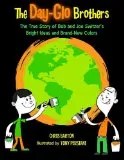Once again, our weekend science fun is inspired by a children’s book. As announced today, the winner of the 2009 Cybils award for nonfiction picture book is The Day-Glo Brothers by Chris Barton
and illustrated by Tony Persiani. If you are interested in children’s and young adult books, you might want to see the winners in all the categories. I reviewed The Day-Glo Brothers at Wrapped in Foil this week.
The Switzer brothers, Bob and Joe, were fascinated by science, probably due to the fact their father was a pharmacist. Their interest in glowing colors started when Bob had a bad accident which kept him confined to home. His brother Joe kept Bob company by playing around with an ultraviolet lamp (also called a black light). Joe, a magician, realized he might be able to use fluorescent paint and ultraviolet light to create an illusion, so the brothers began to experiment.
Knowing that there were commercial uses for fluorescent paints, the brothers started to investigate paints that would glow in regular daylight, not just under ultraviolet light. They eventually created the eye-popping Day-Glo colors found today in products as diverse as highlighters and traffic cones.
Let’s do some investigations with glowing light sources of our own.
1. Glowing under ultraviolet light
Gather:
- a black light
- petroleum jelly
- paper
- tonic water
- kitchen or latex gloves (optional)
Here in Arizona, black lights are easy to obtain from virtually any hardware or home supply store, and for a good reason. It turns out that one of the best ways to find scorpions, which are active at night, is to shine an ultraviolet light on them. Scorpions glow under UV light. For those of you who are curious, Firefly Forest has a great photograph of a glowing scorpion.
How Stuff Works (site has ads) has an explanation of how a black light works. Under normal conditions humans can’t see ultraviolet light, but when ultraviolet light from a black light hits certain objects it releases forms of light that we can see.
Turn off the lights at night, and explore with the black light. What glows? Turn the lights back on and write a simple message in petroleum jelly on a sheet of paper (using the gloves if you don’t like the feel of the jelly). What happens when you turn the lights back off? What happens if you get petroleum jelly on your hands? Take a look at the tonic water and other household items under the black light, too.
For more black light science experiments, check Home Chemistry.
2. Light sticks
Light sticks can glow in the dark without being exposed to light or ultraviolet light to work. The light they give off is the result of a chemical reaction. How Stuff Works has a section about how light sticks work.
You can experiment by comparing the speed of the reaction when you activate a glow stick in warm water versus ice water. You’ll need a timer to time the reaction.
Steve Spangler has a video about light sticks and glowing.
3. Day-Glo Bugs
Entomologists who want to study insect movement sometimes use Day-Glo powders. They mark a group of insects with the bright powder, release them and then recapture the insects after a given period of time, to see where they ended up. This type of experiment is called a mark-recapture experiment. Insects may be recovered with simple equipment, like a butterfly net, or elaborate collecting equipment, such as a huge insect vacuum.
Get some glowing insects, hide them and let the children “re-capture” them.
4. Glowing plastic stars
Younger children love the glowing plastic stars. Use them to create constellations, patterns, etc. My son used to enjoy throwing light-charged plastic stars into the bathtub water and turn off the lights (briefly and with adult supervision). It was fun to see the stars swirl through the water.
Have fun. Who knows where an interest in light and chemistry will lead next?
Disclosure: As a round II Cybils judge, I received a copy of this book for review purposes.


